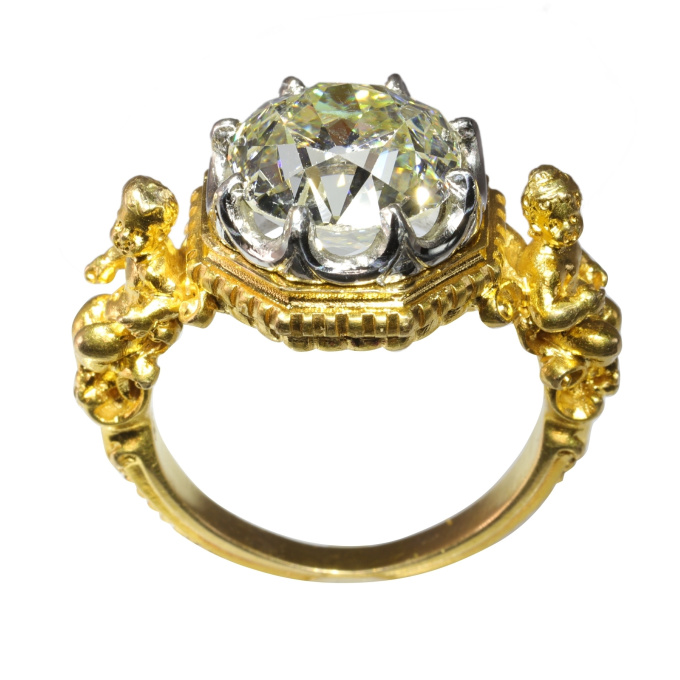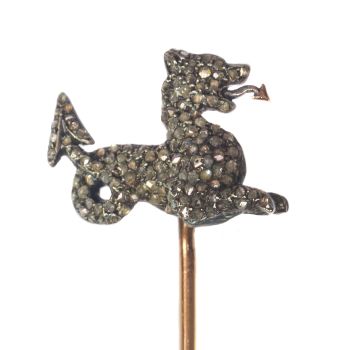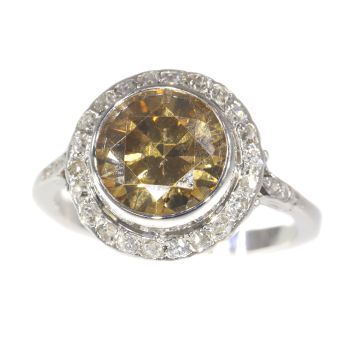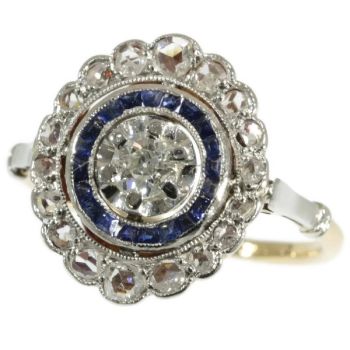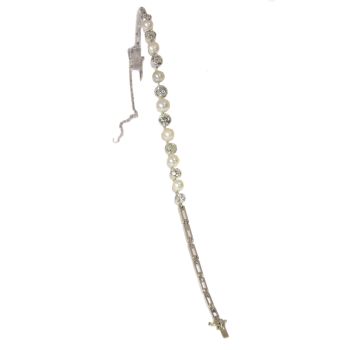Wièse's 4.86ct Diamond Ring, a Neo-Renaissance Legacy 1900
Wièse
DiamanteOroPietra preziosa
€ 120.000
Adin Fine Antique Jewellery
- A proposito di opere d'arte
This Late-Victorian Neo-Renaissance ring by Jules Wièse is a museum-quality marvel in Haute Joaillerie. Crafted in France from 18K yellow gold and platinum, the ring incorporates two putti, symbolic of love and innocence, adding layers of historical andemotional meaning. At its core lies a 4.86-carat old European cut diamond. Wièse's craftsmanship is renowned, even cited in multiple academic books on 19th-century jewellery. Authenticated by Wièse's signature and French hallmarks, this ring is apinnacle of craftsmanship and a timeless heirloom, captivating collectors and destined for future generations to be amazed by its uniqueness.
Antique jewelry object group
ring
Condition
excellent condition
more info on our condition scale
Country of origin
France
Style
Victorian / Neo Renaissance
more info on styles
Style specifics
Neo-Renaissance jewellery refers to pieces inspired by the art and culture of the Renaissance period, which spanned from the 14th to the 17th centuries. Created primarily in the late 19th and early 20thcenturies, Neo-Renaissance jewellery aimed to replicate the grandeur and intricacy of its historical predecessor. Artisans of this movement often utilised traditional materials like gold, enamels, and precious gemstones, meticulously crafting them into elaborate designs that featured a variety of motifs, such as mythological scenes, putti, and intricate floral patterns.
The Neo-Renaissance movement was largely a European phenomenon, with France being a key player in its development. Renowned jewellers like Jules Wièse elevated the craft to new heights, creating pieces that were not mere replicas but original works of art that incorporated Renaissance elements. These jewellery pieces were considered the epitome of luxury and sophistication, valued not just for their materials but also for their exquisite craftsmanship and detailed ornamentation. They are now highly sought after by collectors and can be seen as timeless heirlooms, capable of captivating future generations with their unique blend of history and artistry.
Period
ca. 1900
Events & facts of this era, poetry of this era, fashion of this era.
Source of inspiration
Renaissance
Theme
two putti, one male, one female
The use of two putti—one male, one female—could symbolise romantic or divine love, a union of opposites, or the harmony and balance achieved through such a union.
Material
18K yellow gold and platinum (touchstone tested)
more info on precious metals
Extra information
Louis Wièse was the son of famed 19th-century French jeweller Jules Wièse and continued his father's legacy of exceptional craftsmanship. Like his father, Louis excelled in creating intricate designs inspired by historical and religious themes. His work, often executed in gold and featuring detailed ornamentation, represents some of the finest examples of 19th-century French jewellery. Louis Wièse contributed to maintaining thefamily's esteemed reputation, with pieces today equally coveted by collectors and displayed in significant museums globally.
Diamonds
One old European cut diamond with an estimated weight of ± 4.86ct colour and clarity L, si1 (see pictures for HRD certificat)
Birthstones
Diamond is the birthstone (or month stone) for April.
more info on birthstones
Brand
Wièse
Signature
Wièse (see pictures)
Hallmarks
Wièse mastermark and the French control mark for 18K gold representing an eagle's head that was in use in France from about 1838. (see pictures for close ups)
more info on hallmarks
Dimensions
width top of ring 1,37 cm (0,54 inch)
see picture with a ruler in millimeters and inches
Weight
10,70 gram (6,88 dwt)
Ring size 52
more info on ring sizes
Adin Reference Nº
20027-0039
Copyright photography
Adin, fine antique jewellery
Sources
- Le Bijouterie Francaise au XIX Siècle par Henri Vever (volume 2 page 213 for similar ring)
- Henri Vever French Jewelry of the Nineteenth Century (page 1013)
- Jules Wièse und sien Atelier (similar rings in the book)
- Pariser Schmuck (page 49 for a ring in the same idea & page 44 for the Wièse mark)
- Dictionnaire des joailliers, bijoutiers et orfèvres en France de 1850 à nos jours By: L'École des Art Joailliers avec le soutien de Van Cleef & Arpels.
Additional information
our latest acquisitions
jewelry glossary
wall of fame
visit us in Antwerp
subscribe to our mailinglist
- A proposito di opere artista
Nella seconda metà del diciannovesimo secolo, gli orafi iniziarono a trarre sempre più ispirazione dalle epoche passate, abbracciando manufatti antichi e medievali e facendo rivivere tecniche a lungo dimenticate. In Francia, gli stili del neogotico e del revival rinascimentale acquisirono particolare popolarità, fondendosi in quello che divenne noto come lo "stile cathédrale".
Uno dei luminari di questo movimento di design fu Jules Wièse (1818-1890). Compì il viaggio da Berlino a Parigi nel 1839, intraprendendo una carriera presso il rinomato atelier del gioielliere e argentiere Froment-Meurice. Questo intraprendente artigiano scalò rapidamente i ranghi, raggiungendo il ruolo di direttore del laboratorio nel 1844. L'anno successivo, fece il passo coraggioso di aprire il proprio laboratorio al 7 di rue Jean-Pain-Mollet. Wièse presto si creò una nicchia distinta, specializzandosi nella creazione di gioielli e oggetti d'arte finemente cesellati in argento e oro.
La sua eccezionale maestria non è passata inosservata. Wièse ricevette riconoscimenti all'Exposition Industrielle del 1849 e nel 1855 gli fu assegnata una medaglia di prima classe all'Exposition Universelle. Un critico, commentando il suo lavoro all'esposizione del 1855, osservò: "l'importanza dei suoi pezzi e i suoi audaci esperimenti rivelano un apprezzamento per l'arte e la bellezza che merita il riconoscimento da parte della giuria, anche nel lavoro più modesto". La notevole abilità e originalità di Wièse ottennero presto riconoscimenti internazionali quando fu onorato con una medaglia di distinzione alla Grande Esposizione di Londra del 1862.
Il lavoro di Wièse era una fusione armoniosa di motivi medievali e metodi artigianali tradizionali. Trasse ispirazione dalla leggenda arturiana, dai racconti cavallereschi, dall'architettura gotica e da varie forme d'arte dell'epoca. I suoi gioielli spesso portavano una finitura in ossido di mercurio applicata con cura, conferendo loro un aspetto antico e annerito. Nel caso degli oggetti d'oro, a volte veniva usato il rossetto da gioielliere per dare loro l'aspetto di tesori appena portati alla luce.
Nel 1880 Jules Wièse si ritirò, lasciando le redini del laboratorio al figlio Louis. Descritto da Vever come "un artista eccezionalmente modesto e di vero talento", Louis continuò a produrre gioielli in stile revivalista fino alla chiusura dell'azienda nel 1923.
I gioielli di Wièse, noti per la loro affascinante eccentricità e la squisita fattura, rimangono molto ambiti e ricercati da collezionisti e intenditori. Esempi del suo lavoro possono essere trovati in istituzioni stimate come il British Museum, il Victoria & Albert Museum e il Musée des Arts Décoratifs di Parigi.
Sei interessato ad acquistare questa opera d'arte?
Artwork details
Related artworks
Lawrence Alma-Tadema
"Caracalla and Geta: Bear Fight in The Coliseum, AD 203" 1907
Price on requestGallerease Selected
 Curated by
Curated byDanny Bree
1 - 4 / 24- 1 - 4 / 24
- 1 - 4 / 24
Unknown artist
18th Century Diamond Bracelet with 2000-year-old Intaglios1790
€ 23.000Adin Fine Antique Jewellery
 Curated by
Curated byDanny Bree
1 - 4 / 12

